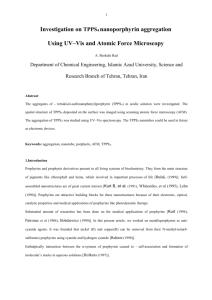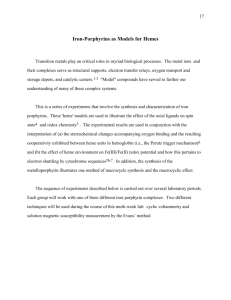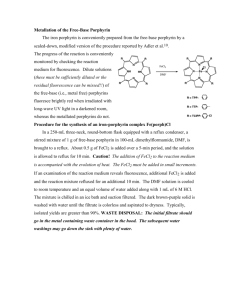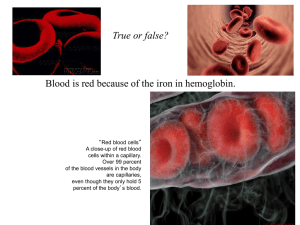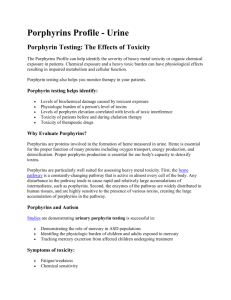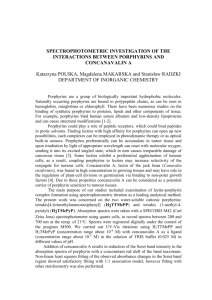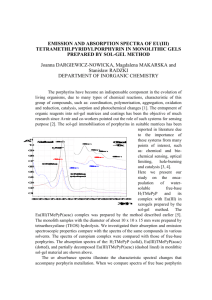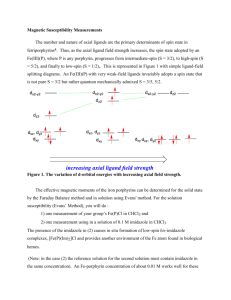Investigation of TPPS4 nanoporphyrin aggregation
advertisement
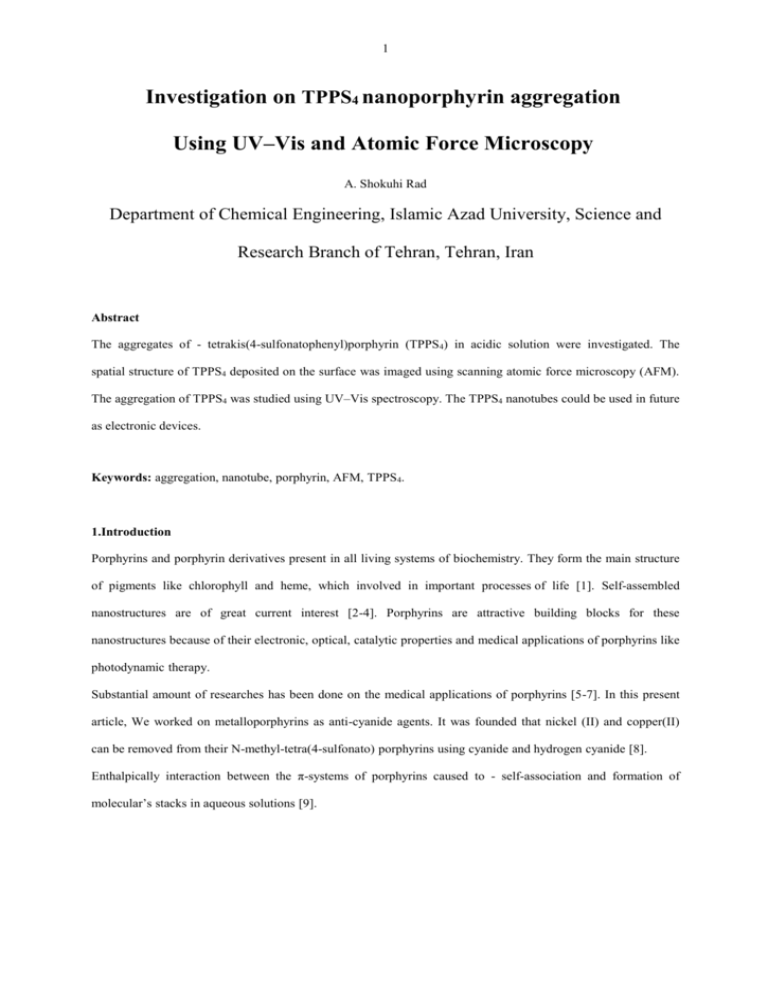
1 Investigation on TPPS4 nanoporphyrin aggregation Using UV–Vis and Atomic Force Microscopy A. Shokuhi Rad Department of Chemical Engineering, Islamic Azad University, Science and Research Branch of Tehran, Tehran, Iran Abstract The aggregates of - tetrakis(4-sulfonatophenyl)porphyrin (TPPS4) in acidic solution were investigated. The spatial structure of TPPS4 deposited on the surface was imaged using scanning atomic force microscopy (AFM). The aggregation of TPPS4 was studied using UV–Vis spectroscopy. The TPPS4 nanotubes could be used in future as electronic devices. Keywords: aggregation, nanotube, porphyrin, AFM, TPPS4. 1.Introduction Porphyrins and porphyrin derivatives present in all living systems of biochemistry. They form the main structure of pigments like chlorophyll and heme, which involved in important processes of life [1]. Self-assembled nanostructures are of great current interest [2-4]. Porphyrins are attractive building blocks for these nanostructures because of their electronic, optical, catalytic properties and medical applications of porphyrins like photodynamic therapy. Substantial amount of researches has been done on the medical applications of porphyrins [5-7]. In this present article, We worked on metalloporphyrins as anti-cyanide agents. It was founded that nickel (II) and copper(II) can be removed from their N-methyl-tetra(4-sulfonato) porphyrins using cyanide and hydrogen cyanide [8]. Enthalpically interaction between the π-systems of porphyrins caused to - self-association and formation of molecular’s stacks in aqueous solutions [9]. 2 One type of molecular assemblies is called J-aggregates [10]. The aggregates are characterized by one optical absorption band (J-band), which has a red shift with respect to the absorption band of the monomers at about 400 nm (known as the Soret band) and several weaker absorptions (Q-bands) at higher wavelengths [11–17]. The structure of-TPPS4 porphyrin molecule in acid aqueous solution was illustrated in Fig. 1. In the presence of chiral groups, the structure has the optical activity of J-aggregates [18, 19]. The supramolecular J-aggregate structures are not completely understood yet and hence, the spectroscopic determination of aggregation numbers doesn’t correspond to the geometrical size of - aggregates [20, 21]. This conclusions was supported by the results of picoseconds spectroscopy, suggesting large aggregates composed of thousands of dye monomers [22]. 2. Experimental Tetraphenylporphine was synthesized by the method of Adler [23], sulfonated [24] and metalated [25]. The Jaggregate solutions were prepared by dissolving TPPS4 in acidic aqueous medium (HCl was used to adjusting the pH value at 1) in the range of concentration between 1×10 −4 to 2×10−6 M. To stabilization of the aggregates formation, the solution was kept at room temperature (25 ċ) for about 10 days. The nanotubes deposited on the glass surface using setting it in TPPS solution for 5 minutes. The glass dried in oven at 70 ċ for 30 minutes. Atomic Force Microscopy confirmed the results of J-aggregates of TPPS4. UV-Vis spectroscopy used for study of absorption changes at different acidic solutions and different time of aggregation. 3. Results and discussion 3.1. Acid aggregation in TPPSx derivatives Fleischer [26] found that H2TPPS4 in acidic media at pH=4, forms a di-acid porphyrin , the related bands were observed at 435, 593 and 645 nm, and at pH values less than 2, the bands appeared at 435, 491, 645 and 707 nm as shown in Fig. 2. Pasternack [27] reported about aggregation of H2TPPS3 in different ionic strength solutions and he studied the extent depending on the identification of the cation used to production of the ionic media. In this present work, other TPPSx derivatives in 0.1 M HCl was studied and it founded that the aggregation is in the order of trans-TPPS2 (fully aggregated)>> cis-TPPS2 >TPPS3 ~ TPPS4 [28]. The order of porphyrin solubility was H2TPPS4 (very soluble) > H2TPPS3 (soluble) > cis-H2TPPS2 (slightly soluble) > trans-H2TPPS2 (very slightly soluble) >> H2 TPPS1 (fairly insoluble). The comparison of these two series shows that the order of porphyrin solubility was in contrast to aggregation. By filtering the aggregated TPPS4 through a 0.45 μm Millipore filter, the porphyrin di-acid passed through and the aggregation form was left in the filter as shown in Fig.2. The 3 H4TPPSx compounds could overlap in an edge-to-edge aggregation larger than 0.45 μm and cause a red shift in the soret band of absorption spectra. H2P porphyrin molecules protonate at the central nitrogen atoms to formation of H 3P+ or H4P2+ in the acidic medium with pH values range of 0 to 3. The equilibrium constants for protonation reactions are: To decrease the presence of dimmers, the total porphyry’s concentrations were near 10 -7 M. The absorption spectra were plotted as a function of pH. The relationship between the observed absorbance A x, the total porphyrin concentration,[P]T, and [H+] is: Where є2 , є3 and є4 are the molar absorptivities of the free base, mono-and di-cations, respectively. Fig. 2 shows a plot of Ax /[P]T versus pH for H2T(2,6-F)PPS . 3.2. UV-Vis and AFM studies of TPPS4 aqueous acid solutions The measured UV–Vis spectrum of the acid solutions (Fig. 3) has maximum absorption at 433, 490 and 705 nm, which has to be attributed to the formation of J-aggregates (490 nm). AFM image of TPPS4 samples deposited on silica, prepared from TPPS 4 aqueous acid solutions at pH=1. The dispersion of nanotubes on glass substrate is given in Figs. 4 and 5. The size of nanotubes from section analysis calculated by section analysis (fig. 6), was about (20×100×200) nm. Comparison between spectroscopic data and AFM images implies that the absorption band at 423 nm and the Jband at 490 nm both together reflect the formation of the ordered structure of TPPS tube - like aggregates [29]. UV–Vis absorption spectra of TPPS4 solution recorded in the middle of aggregation as shown in Fig.7. The absorption decreased by the time ahead and the final spectrum was the nanotube absorption bands. The possible reasons for differences in spectral observed between J-aggregates present in aqueous solution and those formed in the presence of acid, could be related to the assembling and subsequent superficial localization of size-limited aggregated structures. The necessary conditions for the co-precipitation seem to require the presence of TPPS4 monomers as well as highly aggregated species serving as a substrate finalizing the cohesion. 4. Conclusions 4 Aggregated porphyrin materials studied showed nanoporous surfaces, and their applications are promising. Due to the high surface area, nanoporphyrins usually act high efficiency for sensing devices and using different metals makes them suitable for sensors. The J-aggregate composition of - tube walls indicates strong electronic coupling of multiple porphyrin subunits, which might be expected to facilitate the electron transport that is necessary to growing the nanowire. Wide ranges of such properties have been explored, including various non-linear optical behavior and low-dimensional electric conduction. Refrences: [1] Bulak, F ; Autocatalytic Reduction of dichloro 5, 10, 15, 20 tetraphenylporphinatoplatinum(IV) by 1-MethylimidazoleTurk, E. J. Chem. 23 (1999) 407. [2] Whitesides, G. M.; Mathias, J. P.; Seto, C. T. Science , Molecular self-assembly and nanochemistry: a chemical strategy for the synthesis of nanostructures (1991) 1312- 1319. [3] Whitesides, G. M.; Simanek, E. E.; Mathias, J. P.; Seto, C. T.; Chin, D. N.; Mammen, M.; Gordon, D. Noncovalent Synthesis: Using Physical-Organic Chemistry To Make Aggregates Acc. Chem. Res. 28 (1995) 37-44. [4] Lehn, J. M. Perspectives in Supramolecular Chemistry - From Molecular Recognition towards Molecular Information Processing and Self-Organization Angew. Chem., Int. Ed. Engl. 29 (1990) 1304-1319. [5] Kurt B. and Mathias H. An optimized synthesis of manganese meso-tetra(4sulfonatophenyl)porphine: A tumor-selective MRI contrast agent Tetrahedron 50, Issue 29, 1994, 8657-8660. [6] Patronas N. J., Cohen J. S., Knop R. H., Dwyer A. J., Colcher D., Lundy J., Mornex F., Hambright P., Sohn M. and Meyers C. E., Cancer Treat. Rap. 70 (1986) 391. [7] Bohdiewicz P. J., Lavallee D. K., Fawwaz R. A., Newhouse J. H., Oluwole S. F. and Anderson P. O., Invest. Radiol. 25 (1990) 765. [8] Rahimi R., Hambright P., Anti-cyanide drugs: kinetics of the removal of copper(II) and nickel(II) from N-methyl-tetra(4-sulfonatophenyl)porphyrins by cyanide. LD50s of common metalloporphyrins and metallophthalocyanines J. porphyrins phthalocyanines 2 (1998) 493. 5 [9] Hofkens J., Latterini L., Vanoppen P., Faes H., Jeuris K., DeFeyter S., Kerimo J., Barbara P.F., DeSchryver F.C., Rowan A.E., Nolte R.J.M., Mesostructure of evaporated porphyrin thin films; porphyrin wheel formation J. Phys. Chem. B 101 (1997) 10588–10598. [10] Fukutake, T. and Kobayashi T., J-Aggregates, World Scientific Publishing, Singapore, 1996. Chem. Phys. Lett., 2002, 356, 368. [11] Ohno O., Kaizu Y., Kobayashi H., J-aggregate formation of a water-soluble porphyrin in acidic aqueous media J. Chem. Phys. 99 (1993) 4128–4139. [12] Rotomskis R., Augulis R., Snitka V., Valiokas R., Liedberg B., Hierarchical structure of TPPS4 Jaggregates on substrate revealed by atomic force microscopy, J. Phys. Chem. B 108 (9) (2004) 2833– 2838. [13] Okada S., Segawa H., Substituent-control exciton in J-aggregates of protonated water-insoluble porphyrins J. Am. Chem. Soc. 125 (2003) 2792–2796. [14] Kano H., Saito T., Kobayasashi T., Dynamic intensity borrowing in porphyrin by sub-5-fs spectroscopy J. Phys. Chem. B 105 (2001) 413–419. [15] Kano K., Fukuda K., Wakami H., Nishiyabu R., pasternack R.F. , Factors Influencing SelfAggregation Tendencies of Cationic Porphyrins in Aqueous Solution J. Am. Chem. of Soc. 122 (2000) 7494–7502. [16] Pasternack R.F., Fleming C., Herring S., Collings P.J., dePaula J., DeCastro G., Gibbs E.J., Aggregation kinetics of extended porphyrin and cyanine dye assemblies Biophys.J. 79 (2000) 550–560. [17] Rubires R., Crusats J., El-Hahemi Z., Jaramillo T., Lopez M., Valls E., Farrera J.A., Ribo J.M., Self-assembly in water of the sodium salts of meso-sulfonatophenyl substituted porphyrins New J. Chem. (1999) 189–198. [18] Huang X., Nakanishi K., Berova N., Porphyrins and metalloporphyrins: versatile circular dichroic reporter groups for structural studies, Chirality 12 (2000) 237–255. [19] Kano,H. T. Saito, Kobayasashi T., Dynamic intensity borrowing in porphyrin by sub-5-fs spectroscopy J. Phys. Chem. B 105 (2001) 413–419. [20] Harrison W J, Mateer D L and Tiddy G T. Liquid-Crystalline J-Aggregates Formed by Aqueous Ionic Cyanine Dyes. J. Phys. Chem. , 1996, 100: 2310-2314. 6 [21] Yao H., Ikeda H., Kitamura N., Surface-Induced J Aggregation of Pseudoisocyanine Dye at a Glass/Solution Interface Studied by Total-Internal-Reflection Fluorescence Spectroscopy. J. Phys. Chem. B 102 (1998) 7691–7694. [22] Herzog B., Huber K., Stegemeyer H., Aggregation of a Pseudoisocyanine Chloride in Aqueous NaCl Solution Langmuir 19 (2003) 5223–5232. [23] Alan D. Adler, Frederick R. Longo, John D. Finarelli, Joel Goldmacher, Jacques Assour, Leonard Korsakoff, A simplified synthesis for meso-tetraphenylporphine J. Org. Chem. 32(1967) 476. [24] Krishnamurthy, M. 1977. Kinetics of anation reactions of a water-soluble rhodium(III) porphyrin. Inorg. Chim. Acta. 25:215–218 [25] Krishnamurthy M. , Solution chemistry of silver porphyrins. 1. Demetalation Inorg. Chem. 17 (1978) 2242. [26] Fleischer, EB; Palmer, JM; Srivastava, TS; Chatterjee, A. Thermodynamic and kinetic properties of an iron-porphyrin system. J Am Chem Soc. 1971 Jun 30;93(13):3162–3167 [27] Pasternack, R.F., Huber, P.R., Boyd, P., Engasser, G., Francesconi, L., Gibbs, E., Fasella, P., Cerio Venturo, G., and Hinds, L.deC. (1972). On the aggregation of meso-substituted water soluble porphyrins. J. Am. Chem. Soc. 94, 4511 4517. [28] Sutter T. P. G., Rahimi R., Hambright P., Steric and InductiveEffects on the Basicity of Porphyrins and on the Site of Protonation of Porphyrin Dianions: adioiytic Reducton of Porphyrins and Metaiioporphyrins to chiorins or Phiorins J. Chem. Soc. Faraday Trans. 89(3) (1993) 495-502. [29] Valanciunaite J., Poderys V., Bagdonas S., Rotomskis R., Selskis A., J. of Physics: Conference Series 61 Protein induced formation of porphyrin (TPPS4) nanostructures (2007) 1207–1211. 7 Fig. 1. The structure of the TPPS4 porphyrin diacid (H6TPPS42+) in pH =1 solution. 8 Fig. 2. pH profile of the protonation reactions of H 2T(2,6-F)PPS (0.1M NaNO3). Insert: the four-band spectrum of aggregated TPPS4 after passage through a 0.45 μm millipore filter. 9 3 2,5 Absorbance 2 1,5 1 0,5 0 350 400 450 500 550 600 650 700 750 800 wavelength (nm) Fig. 3. UV–Vis absorption spectra of TPPS4 solution by changing the pH from 4 to 1. 10 Fig. 4. AFM image of TPPS4 sample on silica prepared from TPPS4 aqueous acid solutions (pH=1). 11 Fig. 5. AFM image (from above) of TPPS4 sample on silica. 12 Fig. 6. AFM section analysis of TPPS4 samples on silica. 13 3 82 min 90 min 2,5 98 min 115 min Absorbance 2 127 min 1,5 140 min 160 min 1 180 min 195 min 0,5 210 min 14 hour 0 350 400 450 500 550 600 650 700 750 wavelength (nm) Fig. 7. UV–Vis absorption spectra of TPPS4 solution by the different time of aggregation.
